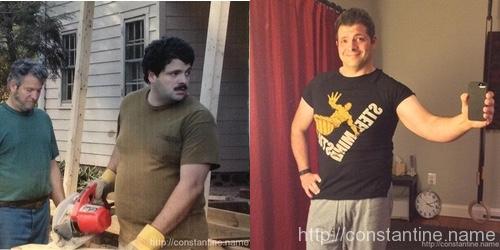This entry is part 69 of 72 in the series
My JourneyRecently a friend of mine emailed me and asked, “Hey Craig, tell me about that diet you went on a few years ago.” He was referring to what I did from ~2008 to ~2016—the photos above were taken in 2008 and 2016. Below is my response and this just happens to all coincide with the “ten year challenge” currently all over social media.
I did a few things. Each of these took a few months of trying/fiddling until they felt comfortable.
I tried to avoid refined carbs like the plague; I tried to eliminate all added sugar, all refined grain (bread, pasta, etc), and even eliminated granola which was a go-to breakfast staple (with plain yogurt). What really happened was that it forced me to become aware of the carbohydrates I was eating. I still ate pasta and bread and even sweets, but by focusing on, “I am the type of person who eats fish, meat and veggies,” I was able to shift my diet significantly. I started to make choices such as, “if I’m going to eat pasta, I’m not eating shitty pasta, I’m going to my favorite Italian restaurant so I really enjoy it.” I did not count calories. This was not fun as I [in my opinion] was addicted to the blood sugar spikes from eating a lot of carbohydrates. Shifting my dietary balance had the effect of changing my energy metabolism; it caused changes in my liver function and cellular mitochondria performance.
After many months of that, I next worked on my addiction to eating. I started intermittent fasting. (Without consulting my doctor I just jumped all in.) I did (and still do, many years later) “16/8” intermittent fasting; meaning I’m fasting 16 hours-a-day, and permit myself an 8-hour “feeding window.” (Aside: What I now call ‘normal human eating.’) The way I like to do this is to aim for consuming no food after about 7:30pm. That makes it easy to have a normal dinner, including social eating which is super important to me. Then I basically don’t eat breakfast. Around 11:30, (16 hours after 7:30 the previous day,) I have my break-fast while everyone else is calling it “lunch.” Most people never notice I’m doing this. I could talk for hours about intermittent fasting. BE CAREFUL with this; you can faint, or have low-blood sugar problems depending on how wacked your metabolism is.
It’s important to note that I did the above things separately, one after the other. My reading indicated that reducing carbohydrate intake would force my cells to up-regulate all the cellular processes for burning fat—my own pre-installed fat. So my “lower carbohydrates” work was in preparation for the intermittent fasting work. If I was planning to not eat for 16 hours, my body will have to switch to mobilizing the fat from fat cells; the liver has to be able to put glucose into my blood stream from stored-like-a-battery glycogen in the liver, and from glucose created chemically from other substrates. Those in particular were cellular processes that I was hardly using for decades, when I was always-eating and eating lots of carbohydrates.
So the big picture for me was to change my energy metabolism—to recover my [natural, normal, hey humans are awesome] ability to run on various fuels, (be that carbohydrates, protein, or fat I put in my face, or the pre-installed fat.) I did that by first reducing carbohydrates, and then starting to fast.
I’ve written some of my thoughts up on my web site, but it’s all scattered about. Let me know if you want more information on any of the above and I can give you more and point you to specific resources. If you want to learn more, start with my health or self-improvement tags.
All that said…
I’M INSANELY HAPPY I DID ALL THE ABOVE.
I can train like a machine all morning, not having eaten—in fact, if I eat I feel worse when I try to work hard. I’m considering using longer fasts (days, even up to a week) because there are long-term benefits seen in some studies; fast for a week, have improved blood markers for months. But this is definitely out in the land of, “I’m experimenting on myself.” (If you want to learn about long-term fasts, check out Peter Atia’s podcast, The Nothing Burger, it’s a long discussion of a one-week long fast he did with insane amounts of medical science.)
Finally—this is subtle but important—I did not intentionally increase my physical activity. It was not, “I’m exercising to get in shape.” My activity level spontaneously went up in response to feeling better. “I feel like running 2 miles,” is a thought I now have [sometimes] and now I can go run just for fun. It’s a virtuous cycle though; I feel better, I feel like more activity, I feel more better, I feel like more activity, …
ɕ
